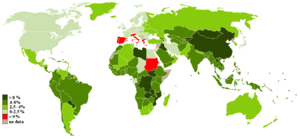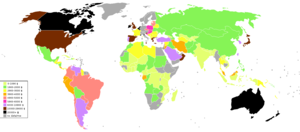
Developing countries, or Majority World, and/or the inaccurate, out-of-date terms the South[1] and Third world all refer to the countries that rank the lowest on the Human Development Index.
History[edit | edit source]
Many developing countries have been colonised. While this a clearly exploitative arrangement to the benefit of the colonizing power, it has also had some positive economic influences, as foreign companies and together with it, foreign knowledge and crafsmanship have then started to enter the country, and some new forms of industry have emerged. However, it has also often left scars when the colonial powers exited the country, and local knowledge/expertise needed for these industries has not been developed.
Economic growth[edit | edit source]


Throughout history, economic development has varied depending on the developing country in question. For example, most African countries experienced little economic growth in the 20th century. Most Asian countries have seen comparatively much more development, with a strong reduction in poverty.
In recent decades though, poverty has decreased dramatically overall thanks to China's strong growth. See the World Economic Outlook 2012 map
Population growth and effect on climate change[edit | edit source]
As mentioned at Population growth, it is the combination of both the population size, as the (degree of) participation of each member on the economy, as the way in which each member chooses to use this wealth that determines our impact on the environment (in regards to climate change).
As in developing countries there is little participation of each member on the economy, the impact of the people in developing countries (ie the "wealthy") have a far greater than the impact, although they are far small in number..[2]
Still, regardless of the facts, "developed" countries often occuse "developing" countries of emitting too much CO2. This leads activists to ask questions such as: Is this what development really is? Is this the benchmark that our countries aim to achieve? If the rampant rise of consumerism is the real cause of global warming, then shouldn't that be targeted? Are it not mostly[3] the developed countries (in relation to their population/country's size[4][5] that should be held responsible?
A study by Dr David Satterthwaite[6] of the International Institute for Environment and Development analyzed changes in population and in greenhouse gas emissions for the entire world. His research, which assessed data between 1980 and 2005 reveals that population growth's contribution to the rise in greenhouse gases are almost negligible.
Sub-Saharan Africa, which had 18.5% of the world's population growth had only 2.4% of the total carbon dioxide emissions, whilst the United States, with 3.4% population growth had 12.6% growth in carbon dioxide emissions.[7]
The study illustrates that low-income countries have a higher rate of population growth, as opposed to higher income countries who maintained a low population rate, but also that they contribute less to global warming than all of us would believe. The study further asserts that the real problem is the growth in consumers and consumerism– not just "people."
"A child borne into a very poor African household who during their life never escapes from poverty contributes very little to climate change, especially if they die young, as many do," says Satterthwaite. "A child born into a wealthy household in North America or Europe and enjoys a full life and a high-consumption lifestyle contributes far more – thousands or even tens of thousands of times more."
Consider China, a country that has strict limits on the growth of their population. In fact, their rates of population growth have decreased enormously. Yet, the rate of their greenhouse gas emissions have increased.
Environmental efforts[edit | edit source]
Many developing countries have already much to suffer from climate change. For some[8] things will become even far worse and will see their entire country vanish due to climate change. This as well as other environmental problems such as deforestation raises great concern on the population -especially as due to being more directly dependant on the environment (ie many people still need to manually collect potable water, firewood,... directly from the environment) they can easily see the devastating impact this will have on their lives/livelihood-.
However, despite the huge threat that climate change faces, many developing countries lack funding and so are less able than developed countries to find appropriate solutions to counter this. In treaties such as the Kyoto protocol, it has been arranged that developing countries hence do not need to reduce their emissions as much as developed countries. Although this indeed makes sense, it should be noted that the Kyoto protocol was only but a stepping stone to reduce emissions and not a final solution. The emission reductions noted herein are nowhere near what is needed to aduquatly reduce emissions. With a more aduquate protocol, emission reductions of even developing countries would be on par to the emission reductions asked from developed countries today, and developed countries would need to attain far higher emission reductions. In practice, this could be easily done and the impression that developing countries could not achieve this is incorrect. This as reducing emissions can be done at various ways, using both high-tech solutions (ie reducing emissions from industry/transport) as low-tech solutions (ie population management, energy-efficient food production,...).[9] In addition, with more efficient use of energy, even high-tech solutions (reducing emissions from industry/transport) can be handled by developing countries. TokelauW for example has switched to using only solar energy and renewable energy (coconut) oil.
In addition, tackling climate change may even prove economically beneficial to (certain) developing countries. For example REDD allows countries to attain revenue simply by leaving their forests standing. Also, the flexible mechanisms (JI, CDM) allow to attract foreign investment/development.
Besides tackling climate change, other environmental projects may also be beneficial to the economy. Especially projects that recycles waste/litter from abroad (ie from developed countries), allows the injecting of capital to the country. An example is the Flip Flop Recycling Project.
Notes and references[edit | edit source]
- ↑ Although a convenient shorthand, the "South" is a inaccurate term as it suggests that the developing nations are further South than the developed nations. Consider Australia and Mongolia as two obvious counter-examples. Further, consider Albania, Japan and Malaysia as counter-examples to the idea of countries in the same region belonging to the same economic class.
- ↑ Stop blaming the poor. It's the wally yachters who are burning the planet, George Monbiot, guardian.co.uk, 28 September 2009
- ↑ China, India, Brazil are developing countries yet are responsible to huge amounts of GHG emissions
- ↑ Countries as the USA are quickly blamed for having the greatest carbon footprint, but are not the greatest emitters in regards to their population/country size, certain Middle Eastern countries are
- ↑ General list of emitters, not taking into account the size of the country/population
- ↑ Study shatters myth that population growth is a major driver of climate change, September, 2009, summary on the website of the International Institute for Environment and Development, and download link for report.
- ↑ Compared to their previous emissions or the increase in global global emissions ?
- ↑ Ie low-lying islands as Mauritius, Fiji,, Kiribati, Tuvalu, Micronesia,... and even some low-lying countries as Bangladesh
- ↑ http://jnmocc.blogspot.com